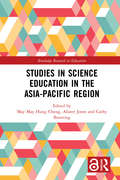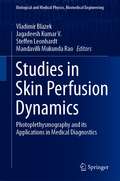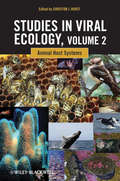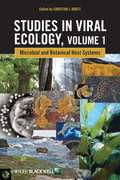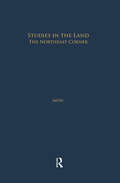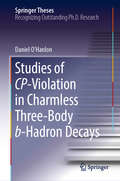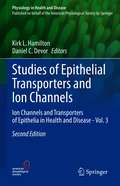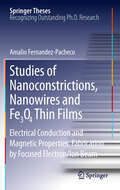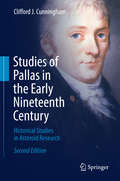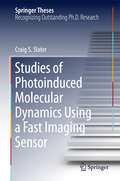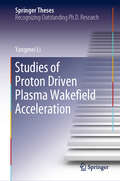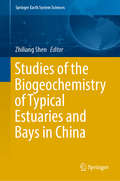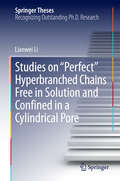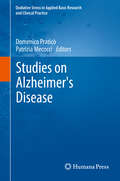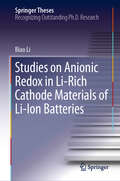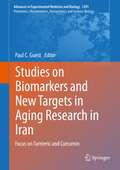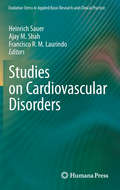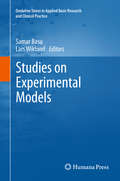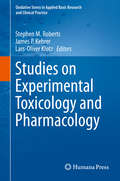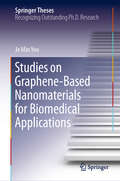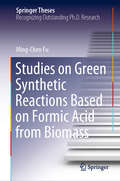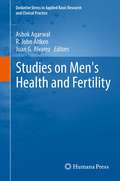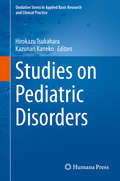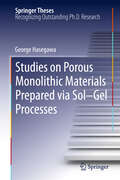- Table View
- List View
Studies in Science Education in the Asia-Pacific Region (Routledge Research in Education)
by Alister Jones Cathy Buntting May ChengConsistent with international trends, there is an active pursuit of more engaging science education in the Asia-Pacific region. The aim of this book is to bring together some examples of research being undertaken at a range of levels, from studies of curriculum and assessment tools, to classroom case studies, and investigations into models of teacher professional learning and development. While neither a comprehensive nor definitive representation of the work that is being carried out in the region, the contributions—from China, Hong Kong, Taiwan, Korea, Japan, Singapore, Australia, and New Zealand—give a taste of some of the issues being explored, and the hopes that researchers have of positively influencing the types of science education experienced by school students. The purpose of this book is therefore to share contextual information related to science education in the Asia-Pacific region, as well as offering insights for conducting studies in this region and outlining possible questions for further investigation. In addition, we anticipate that the specific resources and strategies introduced in this book will provide a useful reference for curriculum developers and science educators when they design school science curricula and science both pre-service and in-service teacher education programmes. The first section of the book examines features of science learners and learning, and includes studies investigating the processes associated with science conceptual learning, scientific inquiry, model construction, and students’ attitudes towards science. The second section focuses on teachers and teaching. It discusses some more innovative teaching approaches adopted in the region, including the use of group work, inquiry-based instruction, developing scientific literacy, and the use of questions and analogies. The third section reports on initiatives related to assessments and curriculum reform, including initiatives associated with school-based assessment, formative assessment strategies, and teacher support accompanying curriculum reform.
Studies in Skin Perfusion Dynamics: Photoplethysmography and its Applications in Medical Diagnostics (Biological and Medical Physics, Biomedical Engineering)
by Steffen Leonhardt Vladimir Blazek Jagadeesh Kumar V. Mandavilli Mukunda RaoThis book talks about photoplethysmography (PPG) techniques based on computer-aided data processing. In particular, it presents the results of a co-operative Indo-German project on the topic between Indian Institute of Technology at Chennai and RWTH Aachen University. Measuring system design, experimental details and some preliminary results obtained so far within the framework of this project are presented here. From the investigations carried out so far using the PPG sensors in conjunction with breathing sensors, it has been possible to monitor the 0.125 to 0.15 Hz rhythms in the arterial volumetric changes and to study the influence of breathing on them. These rhythms, which according to medical experts have relevance to psychosomatic conditions e.g. stress or relaxation, can also be addressed to by ancient Indian practices like yoga and meditation. This book presents the results of studying the effects of Indian relaxation techniques like pranayama, meditation, etc. in comparison to western relaxation techniques like autogenic training. So far it has been established that the Indian techniques of relaxation like yoga and meditation are very effective in generating low frequency rhythms in the skin perfusion as monitored by optical sensors. According to medical experts, these low frequency rhythms have a very important bearing on the human physiology and have potential therapeutic implications. This book is meant to provide an overview of the current state-of-knowledge and encourage the next generation of scientists/engineers to carry this work forward, especially on the novel PPG application fields that are of growing importance like pain and stress assessment, detection of peripheral venous saturation and local arterio-venous oxygen consumption as well as contactless space resolved skin perfusion studies with modern camera based PPG technology.
Studies in Viral Ecology: Animal Host Systems
by Christon J. HurstThis book explains the ecology of viruses by examining their interactive dynamics with their hosting species (in this volume, in animals), including the types of transmission cycles that viruses have evolved encompassing principal and alternate hosts, vehicles and vectoring species. Examining virology from an organismal biology approach and focusing on the concept that viral infections represent areas of overlap in the ecologies of the involved species, Viral Ecology is essential for students and professionals who either may be non-virologists or virologists whose previous familiarity has been very specialized.
Studies in Viral Ecology: Microbial and Botanical Host Systems
by Christon J. HurstThis book explains the ecology of viruses by examining their interactive dynamics with their hosting species (in this volume, in microbes and plants), including the types of transmission cycles that viruses have evolved encompassing principal and alternate hosts, vehicles, and vectoring species. Examining virology from an organismal biology approach and focusing on the concept that viral infections represent areas of overlap in the ecologies of the involved species, Viral Ecology is essential for students and professionals who either may be non-virologists or virologists whose previous familiarity has been very specialized.
Studies in the Land: The Northeast Corner (Studies in American Popular History and Culture)
by David SmithDrawing on primary documents such as farmer's diaries, small rural papers of the 19th century, and the publications of state agricultural societies, this provocative study presents an intelligent overview into the driving forces of that shaped American history in the Northeast.
Studies of CP-Violation in Charmless Three-Body b-Hadron Decays
by Daniel O'HanlonThis book highlights two essential analyses of data collected during the LHCb experiment, based on the Large Hadron Collider at CERN. The first comprises the first observation and studies of matter-antimatter asymmetries in two three-body b-baryon decays, paving the way for more precise measurements of the relatively unknown decay properties of b-baryon decays. The second is an analysis of a charged B meson decay to three charged pions, where previously large matter-antimatter asymmetries were observed in a model-independent analysis. Here a model of the decay amplitude is constructed using the unitarity-conserving ‘K-matrix’ model for the scalar contributions, so as to gain an understanding of how the previously observed matter-antimatter asymmetries arise; further, the model’s construction yields the most precise and comprehensive study of this decay mode to date.
Studies of Epithelial Transporters and Ion Channels: Ion Channels and Transporters of Epithelia in Health and Disease - Vol. 3 (Physiology in Health and Disease)
by Kirk L. Hamilton Daniel C. DevorThis book discusses unique ion channels and transporters that are located within epithelial tissues of various organs including the kidney, intestine, pancreas and respiratory tract. The authors will show, that each of these channels and transporters play crucial roles in transepithelial ion and fluid transport across epithelia and their responsibility in maintaining homeostasis. The reader gains an understanding of the fundamentals of epithelial ion transport, in terms of function, modelling, regulation, trafficking, structure and pharmacology. This is the third of three volumes highlighting the importance of epithelial ion channels and transporters in basic physiology and pathophysiology of human diseases. The focus of this volume lies with different ion channel and transporter families. Additionally, this volume benefits from pharmaceutical contributors and their insights into recent pre-clinical drug discovery efforts and results from clinical trials. Overall, these chapters offer a more thorough coverage of individual epithelial ion channels and transporters from the 1st Edition, along with eleven new chapters. That makes Volume 3 an insightful contribution for physiology students, scientists and clinicians.
Studies of Nanoconstrictions, Nanowires and Fe3O4 Thin Films
by Amalio Fernandez-PachecoThis work constitutes a detailed study of electrical and magnetic properties in nanometric materials with a range of scales: atomic-sized nanoconstrictions, micro- and nanowires and thin films. Firstly, a novel method of fabricating atomic-sized constrictions in metals is presented; it relies on measuring the conduction of the device while a focused-ion-beam etching process is in progress.
Studies of Pallas in the Early Nineteenth Century
by Clifford J. CunninghamBased on extensive primary sources, many never previously translated into English, this is the definitive account of the discovery of Pallas as it went from being classified as a new planet to reclassification as the second of a previously unknown group of celestial objects. Cunningham, a dedicated scholar of asteroids, includes a large set of newly translated correspondence as well as the many scientific papers about Pallas in addition to sections of Schroeter's 1805 book on the subject. It was Olbers who discovered Pallas in 1802, the second of many asteroids to come that was to be officially identified as such. From the Gold Medal offered by the Paris Academy to solve the mystery of Pallas' gravitational perturbations, to Gauss' Pallas Anagram, Pallas presented a mystery to leading thinkers at the time for some time after it was discovered, however. Representing an intersection of science, mathematics, and philosophy, the puzzle of Pallas occupied the thoughts of an amazing panorama of intellectual giants in Europe in the early 1800s.
Studies of Photoinduced Molecular Dynamics Using a Fast Imaging Sensor
by Craig S. SlaterThe work presented in this thesis involves a number of sophisticated experiments highlighting novel applications of the Pixel Imaging Mass Spectrometry (PImMS) camera in the field of photoinduced molecular dynamics. This approach represents the union of a new enabling technology (a multiple memory register, CMOS-based pixel detector) with several modern chemical physics approaches and represents a significant leap forward in capabilities. Applications demonstrated include three-dimensional imaging of photofragment Newton spheres, simultaneous electron-ion detection using a single sensor, and ion-ion velocity correlation measurements that open the door to novel covariance imaging experiments. When combined with Coulomb explosion imaging, such an approach is demonstrated to allow the measurement of molecular structure and motion on a femtosecond timescale. This is illustrated through the controlled photoexcitation of torsional motion in biphenyl molecules and the subsequent real-time measurement of the torsional angle.
Studies of Proton Driven Plasma Wakefield Acceleration (Springer Theses)
by Yangmei LiThis thesis focuses on a cutting-edge area of research, which is aligned with CERN's mainstream research, the "AWAKE" project, dedicated to proving the capability of accelerating particles to the energy frontier by the high energy proton beam. The author participated in this project and has advanced the plasma wakefield theory and modelling significantly, especially concerning future plasma acceleration based collider design. The thesis addresses electron beam acceleration to high energy whilst preserving its high quality driven by a single short proton bunch in hollow plasma. It also demonstrates stable deceleration of multiple proton bunches in a nonlinear regime with strong resonant wakefield excitation in hollow plasma, and generation of high energy and high quality electron or positron bunches. Further work includes the assessment of transverse instabilities induced by misaligned beams in hollow plasma and enhancement of the wakefield amplitude driven by a self-modulated long proton bunch with a tapered plasma. This work has major potential to impact the next generation of linear colliders and also in the long-term may help develop compact accelerators for use in industrial and medical facilities.
Studies of the Biogeochemistry of Typical Estuaries and Bays in China (Springer Earth System Sciences)
by Zhiliang ShenThis book presents study findings involving the Changjiang River estuary and Jiaozhou Bay, China, etc. It takes a large catchment as a combined ecosystem to study nutrients biogeochemistry and environmental aspects of the Changjiang River. Some of the findings have sparked new research directions, including systematic studies of nutrients in the Changjiang River; sources and control mechanisms of nitrogen and phosphorus in the Changjiang River and its estuary; removal and transport of nutrients in the turbidity maximum zone and upwelling area of the Changjiang estuary; long-term changes in nutrients and ecological responses in the Changjiang River estuary and Jiaozhou Bay; and a study on nutrient structure and nutrient composition of phytoplankton, which are topics at the forefront ofinternational marine The studies address different fields, such as biogeochemistry, marine chemistry, ecology, environmental science, oceanography and biology.
Studies on "Perfect" Hyperbranched Chains Free in Solution and Confined in a Cylindrical Pore
by Lianwei LiLianwei Li's Ph. D. thesis solves a long-standing problem in polymer physics: how does a hyperbranched chain pass through a cylindrical pore smaller than its size under an elongational flow field? The question was asked by the Nobel Laureate, the late Professor de Gennes in the 70s but has never been seriously addressed through real experiments. This thesis outlines how Lianwei Li developed a novel polymerization strategy using a seesaw-type macromonomer to prepare a set of "defect-free" hyperbranched chagins with different overall molar masses and controllable uniform subchain lengths. The author then unearthed how the critical (minimum) flow rate at which a hyperbranched chain can pass through the pore, is dependent on the overall molar mass and the subchain length. The experimental results give a unified description of polymer chains with different topologies passing through a small cylindrical pore, which enables us to separate chains by their topologies instead of their sizes in ultrafiltration. In addition, this research also reveals how the chain structure of amphiphilic hyperbranched block and graft copolymers affect their solution properties, including the establishments of several classic scaling laws that relate the chain size and the intrinsic viscosity to the overall molar mass and the subchain length, respectively. This work has led to numerous publications in high-impact peer-reviewed journals.
Studies on Alzheimer's Disease
by Domenico Praticὸ Patrizia MecocciThis volume systematically reviews the basic science and clinical knowledge of the role of free radicals and antioxidants, collectively known as "oxidative stress," in the pathology of Alzheimer's disease. It describes the most current diagnostic tools, laboratory methods and technology, and suggests ways of prevention and treatment to emphasize the concept of the bench-to-bedside approach. Studies on Alzheimer's Disease provides thorough coverage of emerging technology and medical applications including discussions of biomarkers and antioxidants as therapeutic agents, and several more relevant aspects. In addition, this book promotes the concept of using biomarkers representative of oxidative stress reactions and free-radical damageand describes the effects of antioxidants in treating disease in clinical trials. This content is invaluable to both researchers and clinicians studying the development of and treating patients with Alzheimer's Disease.
Studies on Anionic Redox in Li-Rich Cathode Materials of Li-Ion Batteries (Springer Theses)
by Biao LiThis book presents studies and discussions on anionic redox, which can be used to boost the capacities of cathode electrodes by providing extra electron transfer. This theoretically and practically significant book facilitates the implementation of anionic redox in electrodes for real-world use and accelerates the development of high-energy-density lithium-ion batteries. <p><p> Lithium-ion batteries, as energy storage systems, are playing a more and more important role in powering modern society. However, their energy density is still limited by the low specific capacity of the cathode electrodes. Based on a profound understanding of band theory, the author has achieved considerable advances in tuning the redox process of lithium-rich electrodes to obtain enhanced electrochemical performance, identifying both the stability mechanism of anionic redox in lithium-rich cathode materials, and its activation mechanism in these electrode systems.
Studies on Arthritis and Joint Disorders
by Maria Jose Alcaraz Olga Sánchez-Pernaute Oreste GualilloThis next volume in our established series proposes to systematically review the basic science and clinical knowledge of the role of free radicals and antioxidants, collectively known as "oxidative stress", in the pathology of arthritis and other joint diseases. It will describe the most current diagnostic tools , laboratory methods and technology, to suggest ways of prevention and treatment and to emphasize the concept of the bench-to-bedside approach. The book will also provide specific coverage on emerging technology and medical applications including discussions of biomarkers and antioxidants as therapeutic agents and several more relevant aspects. In addition, the book will promote the concept of using biomarkers representative of oxidative stress reactions and free radical damage , as well as describe the effect of antioxidants in treating disease in clinical trials. The content will be valuable to researchers studying the development of arthritis/joint disease, and clinicians treating patients with these diagnoses.
Studies on Biomarkers and New Targets in Aging Research in Iran: Focus on Turmeric and Curcumin (Advances in Experimental Medicine and Biology #1291)
by Paul C. GuestThe Middle East is known as the cradle of civilization. It was the crossroads of ancient empires and the birthplace of major world religions. Today it is the center of many world issues due to its economic, religious and political importance. Although it has lagged behind many other regions of the world in medicinal research, this has increased dramatically in recent years with increasing numbers of relevant publications and the country of Iran has spearheaded this progress. Much of the research has focused on increasing our understanding of the aging process and attempting to identify biomarkers and natural products to improve the human healthspan. This book provides a comprehensive overview of the research conducted in the Middle East on the health benefits of curcumin, a phytochemical derived from the famous spice turmeric. Hundreds of studies have now been published describing the health benefits of this spice. The importance of this research is exemplified by poor data regarding health and longevity as only 0.08% of the population in Iran consists of individuals over 90 years of age. This is approximately 10 times lower than the percentage of this same age group in the United Kingdom and the United States of America and almost 20 times lower than that in Japan. This book presents a series of reviews and meta-studies describing research which has resulted in identification potential new biomarkers and drug targets for age-related disorders. All of the studies have focussed on the testing of curcumin and related products, which have already shown some promising leads in age-related conditions such as heart-disease, diabetes, cognitive impairment and cancer. The authors in this series come from different centers and cities of Iran, including Mashhad, Tehran, Isfahan, Ahvaz, Birjand, Quchan and Yazd, and many of the chapters feature collaborations with other countries of the Middle East and throughout the world, including Brazil, Italy, Mexico, Oman, Poland, Switzerland, the United Kingdom and the United States of America. This underscores the emergence of the Middle East into this arena of research. The book will be of high interest to scientific and clinical researchers in the subject of aging and age-related disease, and to physicians and pharmaceutical company scientists since it gives insights into the latest strategies, biomarkers and targets involved in the mechanism of action of curcumin to promote healthy aging. It will also provide important information on disease mechanisms related to age-related disorders, as each chapter will be presented in the context of specific chronic diseases.
Studies on Cardiovascular Disorders
by Heinrich Sauer Francisco R. Laurindo Ajay M. ShahThis collection of articles on oxidative stress in clinical practice surveys essential current research in what is a rapidly evolving field. As well as giving the reader a mechanistic overview of how oxidative stress affects cardiovascular disease, it analyzes the potential of a number of therapeutic options that target these pathways. Understanding the complexity of the cellular redox system could lead to the development of better targeted interventions that facilitate patient recovery. Even as large-scale clinical trials of so-called 'simple' antioxidant approaches such as vitamins C and E show that significant benefits for cardiovascular patients remain elusive, Studies on Cardiovascular Disorders demonstrates that such approaches are too simplistic. Beginning with a summary of redox signaling models that could induce the progression of redox-associated cardiovascular disorders, the volume moves on to examine redox-mediated protein modification under physiological and pathophysiological conditions. It provides an outline of the signaling pathways in cardiovascular development during embryogenesis, and what impact these might have in the differentiation process of resident cardiac and blastocyst derived stem cells. Further chapters detail our current knowledge of the influence the sensory nervous system exerts on the cardiovascular system, and the paradoxical role of mitochondria-derived ROS in cardiac protection. In all, almost 30 contributions cover issues as diverse as the antioxidant properties of statins in the heart and the oxidative risk factors for cardiovascular disease in women. A range of medical practitioners will find the contents of Studies on Cardiovascular Disorders provides illuminating insight into the Janus-faced role of ROS in the cardiovascular system.
Studies on Experimental Models
by Samar Basu Lars WiklundThere is a widespread consensus that use of antioxidants as a therapeutic approach may counteract free radical mediated pathologies. However, the role of antioxidants in normal physiology and redox signaling is still in its infancy. Since oxidative stress is related to various diseases and pathologies, scientists are eager to study the disease in humans, but it is not always ethical to study all the aspects of the disease in humans. Thus, it becomes mandatory to study the disease process and the mechanisms behind it through experimental models which generally involve animals, in vitro/cell culture studies, primates and even humans to a certain extent. Studies on Experimental Models contains data on the experimental models or review of such models of oxidative stress in various diseases. It is structured into six sections, which are as follows: diabetes, cardiovascular, neurology, ocular diseases, toxicology/environmental and in vitro/tissue culture. Each section presents a sketch of models in humans, animals and in vitro methods. Taken together, they comprise a valuable reference for basic and clinical scientists, one aimed at contributing to the advancement of oxidative stress research using appropriate animal models.
Studies on Experimental Toxicology and Pharmacology
by Stephen M. Roberts James P. Kehrer Lars-Oliver KlotzThis book focuses on data describing the roles of free radicals and related reactive species, and antioxidants, in the causes and treatments of diseases, examining both clinical and pre-clinical trials, as well as basic research. The book is divided into sub-sections with chapters on toxicological mechanisms, agents that produce toxicity, and special topics including areas such as antioxidant supplements, oxygen toxicity, toxicogenomics, and marine biology. Studies on Experimental Toxicology and Pharmacology promotes the concept of using biomarkers of free radical- and reactive species-induced injury as adjuncts to classical laboratory testing and the ability of antioxidants to provide cellular protection. There is increasing evidence that free radicals and other reactive species are causative, or at least supporting factors, that impact organisms and cause numerous tissue disorders. With contributions from international experts in the field, this volume is a valuable resource for researchers and postgraduate students in toxicology and related fields, as well as clinicians and clinical researchers.
Studies on Graphene-Based Nanomaterials for Biomedical Applications (Springer Theses)
by Je Min YooThis thesis presents various applications of graphene-based nanomaterials, especially in biomedicine. Graphene and its derivatives have gained enormous attention from scientists in all fields of study due to many unprecedented properties. The initial scientific attention was focused on the development of transparent flexible electrodes by exploiting two-dimensional graphene film’s extraordinary electrical and physical properties. Recently, given an increasing evidence of dispersed graphene-based nanomaterials’ biocompatibility, researchers have endeavored to employ these materials in other studies relevant to biomedical technologies. In this respect, the thesis provides a comprehensive review on the synthesis, toxicity, and a few of the key biomedical applications in the first chapter. The following chapter discusses the use of a graphene film as a novel catalyst to oxidatively destroy phenols, which are known to be potentially mutagenic and carcinogenic. Finally, and most importantly, the last chapter introduces the therapeutic role of graphene quantum dots, the smallest graphene-based nanomaterials, for Parkinson’s disease. The results are promising for the use of graphene quantum dots as the basis of future clinical drug candidates for neurodegenerative disorders.
Studies on Green Synthetic Reactions Based on Formic Acid from Biomass (Springer Theses)
by Ming-Chen FuThis book introduces readers to the use of formic acid for efficient organic synthesis. It describes the N-methylation of aromatic and aliphatic amines with formic acid using a boron-based catalyst [B(C6F5)3] in combination with silanes and without the need for an expensive transition metal catalyst. It also shows that formic acid interacts with alkynes and allyl alcohols through a carbonylation process that generates carbon monoxide in situ from nickel and palladium catalysis, respectively, doing away with the need to use high-pressure CO gas and offering a user-friendly and practical method for preparing functionalized α, β- and β, γ-unsaturated carboxylic acids. The findings presented not only enrich the field of ‘C1 chemistry,’ but also support the advancement of green and sustainable chemistry.
Studies on Men's Health and Fertility
by Ashok Agarwal Juan G Alvarez Robert John AitkenStudies on Men's Health and Fertility provides a comprehensive series of up-to-the-minute reviews addressing the role of oxidative stress in the aetiology of reproductive pathologies in the male. This volume represents by far the most detailed, authoritative review of the field that has been produced to date. The text encompasses the basic science of reactive oxygen species (ROS) production by mammalian spermatozoa, the way in which these highly reactive molecules are processed by the germ line and the physiological significance of this redox activity in the generation of a functional gamete. The factors responsible for perturbing the delicate balance between physiological redox signaling on the one hand and oxidative stress on the other are also extensively reviewed and some of the first clues concerning the underlying mechanisms (age, heat, infection, cryostorage, aberrant lipid metabolism), clearly identified. From a clinical perspective there are chapters setting out the methods we should be using to diagnose oxidative stress in the male germ line, a clinical perspective on the aetiology of this condition and detailed considerations of the most suitable means of ameliorating such stress from a therapeutic point of view. Studies on Men's Health and Fertility is intended to provide clinicians and scientists with a snap shot of the current status of this exciting, rapidly moving field. The book will be of value to clinicians interested in strategies for the management of oxidative stress in their infertility patients and scientists wishing to understand the molecular mechanisms underpinning the generation of ROS by these cells and its pathophysiological significance. It was not so long ago that the ability of spermatozoa to generate ROS was a hotly disputed topic. With the publication of this book such doubts can finally be laid to rest. There is now no doubt that these cells actively generate ROS, that oxidative stress is a major contributor to defects in male reproductive health and that the successful clinical management of this condition depends on developing a deeper understanding of the underlying molecular mechanisms. In this quest, Studies on Men's Health and Fertility will be seen as a clear and important milestone.
Studies on Pediatric Disorders
by Kazunari Kaneko Hirokazu TsukaharaThis volume examines the role of oxidative stress in the pathology of numerous pediatric disorders. It covers a wide range of topics including the chemistry and biology of reactive oxygen species and nitric oxide, molecular biology of the enzymes generating these species, clinically useful biomarkers for evaluating oxidative stress status in humans, and the pathophysiology, clinical course and management of a variety of pediatric disorders, among others. The book also describes current diagnostic tools, laboratory methods and technology for treatment and prevention of pediatric disorders It explores emerging technology and medical applications including discussions of biomarkers and antioxidants as therapeutic agents. Written by an international team of experts in both pediatrics and free radical and antioxidant research, Studies on Pediatric Disorders is an invaluable addition to the Oxidative Stress in Applied Basic Research and Clinical Practice series.
Studies on Porous Monolithic Materials Prepared via Sol–Gel Processes
by George HasegawaThis thesis focuses on porous monolithic materials that are not in the forms of particles, fibers, or films. In particular, the synthetic strategy of porous monolithic materials via the sol-gel method accompanied by phase separation, which is characterized as the non-templating method for tailoring well-defined macropores, is described from the basics to actual synthesis. Porous materials are attracting more and more attention in various fields such as electronics, energy storage, catalysis, sensing, adsorbents, biomedical science, and separation science. To date, many efforts have been made to synthesize porous materials in various chemical compositions--organics, inorganics including metals, glasses and ceramics, and organic-inorganic hybrids. Also demonstrated in this thesis are the potential applications of synthesized porous monolithic materials to separation media as well as to electrodes for electric double-layer capacitors (EDLCs) and Li-ion batteries (LIBs). This work is ideal for graduate students in materials science and is also useful to engineers or scientists seeking basic knowledge of porous monolithic materials.
